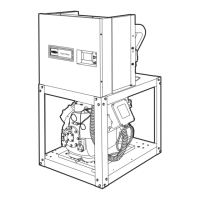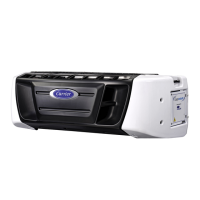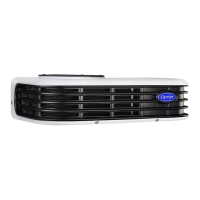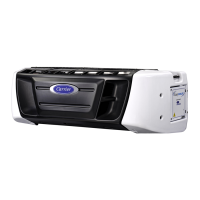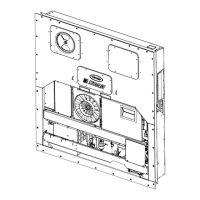62-61753-21
P209 CHECK STANDBY CONT CIRCUIT
TRIGGER-ON: Normal amps for the PSCONR relay coil and PSCON or PSCON2 contactor coils 0.0
to 1.0 Amps (12 VDC). The circuit(s) test outside this range. (During this test either PSCON or
PSCON2 will be tested depending on the phase reversal module.)
UNIT CONTROL: Engine and standby operation: Pretrip will fail and display "PRETRIP FAIL AND
COMPLETED".
RESET CONDITION: Auto Reset if Pretrip is started again, or alarm may be manually reset via key-
pad or by turning the unit off, then back on again.
NOTE: Follow the steps below until a problem is found. Once a repair or correction has been made, clear the
alarm(s). See Note 1 Page 7-1. Operate the unit through the appropriate modes to see if any active alarm occurs.
Continue with the steps below as necessary.
NOTE: IF PRETRIP IS DONE IN STANDBY MODE, THIS PRETRIP ALARM WILL GENERATE MANY OTHER
PRETRIP ALARMS. THEREFORE, IT SHOULD BE ADDRESSED FIRST
a. Inspect PSCONR, PSCON and
PSCON2 contactor coils and wire
connections.
No damage to coils.
No damaged or corroded pins.
b. Check contactor coil resistance.
Refer to Section 2.12 for resistance values
Check PSCONR, PSCON, and PSCON2 Amp Draw
a. Check PSCONR, PSCON and
PSCON2 contactor coils amp
draw.
Use Component Test Mode (Section 5.1.2) to test.
Refer to Section 2.12 for amp values. View current
draw in Data List. FET 19 On.
b. Listen for PSCON or PSCON2 to
pull in.
If PSCON or PSCON2 contactor pulls in, PSCONR and
PSCON or PSCON2 are OK.
If PSCON or PSCON2 contactor does not pull in,
check for voltage at Phase Reversal Module (PRM) "N"
terminal. 12 VDC indicates defective PSCON or
PSCON2 coil. No voltage - check PSCONR and PRM.
(Refer to Section 2.12).
Check PSCONR, PSCON, PSCON2 and PRM Wiring
a. Inspect harness & control box
connector pins & terminals. (See
wiring schematic Section 10.)
See Note 2 & Note 5 on Page 7.2.
No physical damage to harness.
No damaged or corroded pins.

